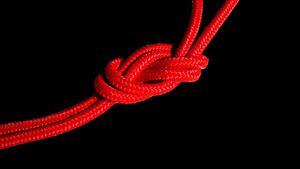Ritual and Obsessions
Recently, my new therapist rolled up a piece of loose leaf paper, twisting until it was a tight, thick cord. She held it up in front of her eyes, the early morning sunlight illuminating the edges on either end. “This is the part of your brain that holds your obsessive-compulsive disorder,” she said, her tone firm. “We can fray this cord, but we can’t just break it.” To illustrate her point, she tried to rip the paper rope in half, straining and pulling to no avail. “We can rip the edges apart, piece by piece. It’s not easy, but it’s doable. It’s going to be a part of you forever.” I imagined a dark red cable, floating somewhere in the space between my ears, demanding my attention every waking moment of the day. It was a type of bondage, really—a force that seemed to exist outside of me, and yet was me. In light of Passover approaching, it seemed particularly cruel that I found myself struggling with the concept of freedom.
At the end of the session, she asked if I had any major plans for the weekend as she jotted down my next appointment in her calendar. I told her I was in the midst of Passover preparation—food had to be made in advance, our Haggadah finalized, and flowers cut and arranged. She wished me a restful holiday as I left her office with reminders to employ my breathing exercises over the next few days. I hadn’t bothered to try and explain the maze of ceremony the weekend would hold. I feared the potential rigidity of ritual would put my brain into overdrive. Like all religious and cultural celebration, Passover is deeply steeped in lore and rooted in history. We move within instructions so established they can be seen as both a comfort and a restraint.
The rest of the afternoon passed in a haze: I helped make base for the two matzo ball soups we’d be serving (one vegetarian, one with chicken shmaltz). While they simmered, I went page by page through our Haggadah copies, marking which pages would be skipped. I circled passages I felt were particularly relevant to this year—this moment—and disregarded those that I felt complicated the intent of the kind of Seder we were trying to hold. It was a slow process—mostly distracted from the task at hand, I tried to force myself to think acceptable thoughts (that is, not worrying about any of my numerous obsessions, which range from house fires to brain tumors). This was a fruitless endeavor. Distraction was important, but it wasn’t foolproof.
This is the second time in my life I have found myself sunk by a disorder widely misunderstood by sufferers and psychologists alike. The first was in seventh grade—at the time, my family and I had no words for the fears that gripped me seemingly overnight. I didn’t know at the time that intrusive thoughts were hallmarks of the disorder, and that early intervention might’ve helped me get a grip on my unraveling psyche. I can only estimate the thousands of hours I spent as a young person imagining, for example, that if I failed to press a song forward on my iPod on an even number my sister would die suddenly. Instead, I stumbled along, throwing myself into schoolwork in the hopes of staving off my own mind.
Sometime before I turned thirteen, the thought spirals lifted. I struggle to write about the end of that period in my life primarily because I don’t want to make it sound as if my fears evaporated overnight. The truth is far murkier: when I was in the midst of it all, I saw no light out. When I eventually did recover (a state of mind you can only point to once you’re thoroughly out of the woods) I suspect my mind behaved defensively afterward, choosing to bury the more frightening details so that I could attempt to move on. Still, the fact that I remember so little of the transition from dark to light led me to believe that it would prove to be a one-time occurrence, a mystery with no name.
As I understand now, having OCD is a lifelong condition. It emerged in my youth, sank into remission, and came back with a vengeance last September, right before Rosh Hashanah. Even as an adult, ten years out from my anxieties of the middle-school era, I didn’t see it for what it was. I met therapists who correctly saw that I was anxious, but couldn’t understand why positive visualizations weren’t working. I tried to let my friends and family know that I felt mentally incapable of thinking any other thoughts besides intrusive ones. This is the part of OCD that isn’t depicted on television. I don’t wash my hands endlessly, but I do lie on my floor for days at a time, unable to think past a mental wall I can’t remember building. Last September, things fell apart. I couldn’t have imagined that I’d still be in the same rut now, six months later. In the context of liberation—the theme of so many Jewish holidays and cultural observance—it is scary to imagine that I may never be free from having obsessive-compulsive disorder. I was raised to see freedom as an absolute: once we were slaves in the land of Egypt, and then we weren’t ever slaves again. In reality, of course, Jews have faced involuntary exodus the world over, the diaspora proving we will never again be a single tribe seeking the promised land. Our existence depends on the hope of something better being just over the horizon. Next year in Jerusalem, perhaps we will celebrate freedom. Next year in Jerusalem, perhaps I’ll be more stable.
Last Friday, my family gathered in our dining room, the table carefully set in anticipation of sundown. I had friends who drove in from out of town to experience their first Seder, and I found myself trying to observe our rituals and traditions from an outside perspective. It occurred to me, as my father began the Kiddush and I nudged my friends to fill their glasses, that I was engaging in acceptable rituals, as opposed to those I had developed to cope with my disorder. I felt soothed by the knowledge that across the world, Jewish people were filling their glasses and smoothing the creases out of their Haggadahs. This was a feeling wholly different from the false rush of momentary relief that comes from engaging in a compulsion, and the juxtaposition was striking. In recent years, I have seen many radically reimagined Haggadahs, and I have loved them all. This ability to shift, to literally rewrite the script from which we act out our identities, has continually shaped my relationship to Judaism on the whole. Freedom may not be a static, absolute state, but neither is mental ruin. My relationship to myself has changed, too. I have no way of knowing how long I’ll have to wait until I can look backward and declare myself healed, but in the meantime, I recognize liberation is not an all-or-nothing journey. Each time I successfully avoid reinforcing my obsessions by acting out a compulsion, I am chipping away, slowly, at the chains that bind.








Thank you so much for this! As someone who also struggles with OCD, this inspired me to really reflect on the relationship I have with Judaism and what that means in the context of obsessions. Chang Semeach for the rest of the week.